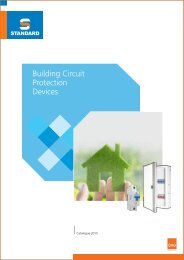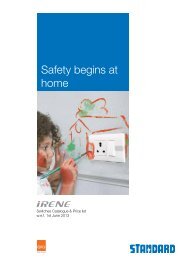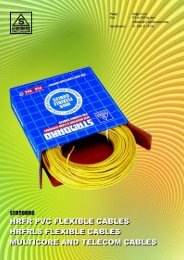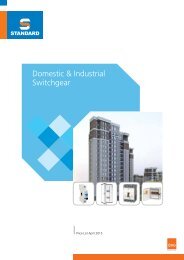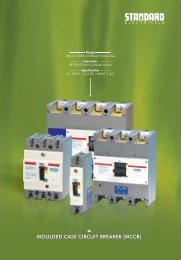Automatic Transfer Switch (ATS)
Automatic Transfer Switch (ATS) - Standard Electricals
Automatic Transfer Switch (ATS) - Standard Electricals
- No tags were found...
You also want an ePaper? Increase the reach of your titles
YUMPU automatically turns print PDFs into web optimized ePapers that Google loves.
<strong>Automatic</strong> <strong>Transfer</strong> <strong>Switch</strong> (<strong>ATS</strong>)
1High speed transfer2Superior making & breaking capacity3Compact & light weight design4Positive indication through flag indicator
<strong>Automatic</strong> <strong>Transfer</strong> <strong>Switch</strong> (<strong>ATS</strong>)The need for continuous power supply and its reliability has increasedrapidly over the years, especially in all those areas where uninterruptedpower supply is a must. Modern systems are power dependent. Theircomplexity has increased as continuous information and communicationsare needed to control automated process, be in industries, commercialcomplexes, hospitals, hotels or even modern residences.The need, as such, for independent stand by power system has thereforeincreased manifold. The power distribution, control, monitoring andprotection of stand by power system needs to be integrated. Stand bygenerator systems, for example, are required to cater to :-• Sensitive Loads are supplied by UPS systems. The period of nonavailabilityof power, before the stand by supply takes over, is bridgedby battery banks. Typical loads are computers, hospital equipments,micro processor controlled industrial machines etc.• Critical Loads mostly involve stand by generator systems which supplypower to lighting systems, air conditioning, elevators etc in Airports,Hotels and commercial complexes.• Essential Loads also use stand by generator systems mostly in processindustries as they relate to high restarting times or high down times.<strong>Automatic</strong> transfer from main supply to stand by supply is vital for all theabove kinds of loads.In the event of power failure, the stand by power is usually expected to takeover automatically. Electrical starting equipment, battery bank and dieselgenerator are required for the automatic operation.The automatic transfer is achieved mostly by automatic mains failuresystems. The process of onload transfer has to be monitored & controlledfor a smooth Changeover and within safety limits of all elements of thesystem. This is achieved by <strong>Automatic</strong> <strong>Transfer</strong> <strong>Switch</strong> (<strong>ATS</strong>). RangeFeatures• High speed transfer• Superior making & breaking capacity• Compact & light weight design• Positive indication through flag indicator• Neutral point transfer• Liberal terminals• Phase barriers RangeRangeSpecificationCurrent rating from 100A to 630A in three frame sizes in three poleand four pole execution.Conforms to IS/IEC:60947-6-184
<strong>Automatic</strong> <strong>Transfer</strong> <strong>Switch</strong> (<strong>ATS</strong>)Cross sectional view of single pole of <strong>ATS</strong>Operating Shaft for ContactsStandby Supply - Incoming TerminalsCommon outgoing - Load TerminalsHousing for Arc ChuteFrameMain Supply - Incoming TerminalsMoving ContactFixed ContactName PlateControl Circuit Terminal BlockEarthing Terminal<strong>ATS</strong> Controller UnitTrip ButtonSelector (Source-II)On / Off Indicators (Source I & II)Main Supply TerminalsArc Extinguishing Chambers<strong>ATS</strong> Protection Unit (optional)Control WiringManual Operating HandleActuator For Closing CoilAuxilliary <strong>Switch</strong> (2 nos.)Standby Supply TerminalsTerminals For LoadConstructionThe <strong>Switch</strong> comprises of upto four symmetrical poles coupled with theMain Operating Mechanism. The switching mechanism is quick make,quick break type. Load terminals are given on the Lower side but canalso be provided on the upper side.Contact MechanismThe contact system is housed in a frame made of Polyester reinforcedglass material. Each pole has two independent set of Moving contactassemblies for Main & standby supply and one Fixed contact assemblyfor the common outgoing load terminals. The Moving assemblies aremechanically operated by Cams when rotated by the Main OperatingMechanism. Moving Contacts make on to Fixed Contacts underconstant pressure with backup spring. Main Contacts are made ofSilver-Tungsten to ensure anti-weld characteristics. The Arc Chuteplates placed in the path of contact, efficiently quench the Arc andthere by enhance the life of the contacts.Main Operating MechanismThe main mechanism independently actuates two sets of Cam linkages,which in turn operate the two independent moving contact assemblies.The closing command is through a Solenoid Coil supplied with 220VAC. The operating mechanism always responds by closing on themain supply side and not on to standby supply side, when bothsupplies are present.The tripping coil, when energised, is used to bring the <strong>ATS</strong> to OFF /Neutral position.Closing on to the standby supply is achieved through the selective coil.The energisation of selective coil, disengages the main mechanismand prevents closing on to the main supply. The solenoid coil can thenclose the second set of moving contacts on to the standby supply.The moving contact mechanism of the main supply and the standby supplyare inherently mechanically interlocked through a double throw arrangement,which ensures that at no point of time two supplies are paralleled.85
<strong>Automatic</strong> <strong>Transfer</strong> <strong>Switch</strong> (<strong>ATS</strong>)Operation (<strong>Automatic</strong>)In the event of main supply being available, the <strong>ATS</strong> can beinstantaneously switched ON, by the closing coil C, through terminalsA1, A2, from its OFF / Neutral position.If the <strong>ATS</strong> is ON at the standby supply position, then it is first trippedby the trip coil TC, through terminals BT1 - BT2. This ensures that thetwo sources of supply are not paralleled. A suitable external controlcircuit will ensure this, as shown in circuit diagram for <strong>Automatic</strong>Instantaneous Changeover mode.The Auxiliary <strong>Switch</strong>es AX or BX, disconnect the closing coil C, oncethe <strong>ATS</strong> is ON, thereby the power consumption of the coil C is zero,when the <strong>ATS</strong> is closed.To switch the <strong>ATS</strong> to standby supply, the selective coil SC is firstenergised. Then the closing coil C is powered through limit swtichesLS and terminals B 1, B 2.The Trip Coil TC, can be energised through AT 1 - AT 2 or BT1 - BT 2 toswitch off the main supply or standby supply.Operation (II emergency)In an emergency, the <strong>ATS</strong> can be operated manually, but as an offloadswitch only.45° Click to lockClose on to Standby SupplyClosure on to standby supply side is achieved, when the “selective”mode is continously pressed and the manual handle rotates theoperating shaft by about 45° in anticlockwise direction.TripTripping can be achieved manually by pressing momentarily throughthe “Trip Button”.Closing <strong>ATS</strong> manually to source-II1. Keep selector pressed using a screwdriver through the selectorhole as shown2. <strong>Switch</strong> to source-II (mains) by rotating the handle upwards thoughan angle (approximately 45°)Closing <strong>ATS</strong> manually to source-I<strong>Switch</strong> to source-I (mains) by rotating the handle upwards though anangle (approximately 45°)45°Keep selector pressedusing a screwdriver86
<strong>Automatic</strong> <strong>Transfer</strong> <strong>Switch</strong> (<strong>ATS</strong>)Technical informationFrame Size TNFO1 TNFO2 TNFO3Rated Operational Current l e A 100 160 200 315 400 630No. Of Poles 3P / 4P 3P / 4P 3P / 4P 3P/4P 3P / 4P 3P / 4PRated Insulation Voltage U i V 1000 1000 1000 1000 1000 1000Rated Operational Voltage U e V 415V AC / 110V DC 415V AC / 110V DC 415V AC / 110V DCRated Frequency Hz 50 50 50 50 50 50Class Pc Pc Pc Pc Pc PcUtilization Category AC 31A AC 31A AC 31A AC 31a AC 31A AC 31ADielectric Strength Kv 5 5 5 5 5 5Rated Impulse Withstand Voltage U imp Kv 8 8 8 8 8 8Rated Making Capacity At 415V (Cosø = 0.80) A 1000 1600 2000 3150 4000 6300Rated Breaking Capacity At 415V (Cosø = 0.80) A 800 1280 1600 2520 3200 5040Rated Short Time Withstand Current (1 Sec) KA rms 5 7 10 12 12 15Fuse Protected S/C Withstand Current KA rms 80 80 80 80 80 80Rated Short Circuit Making Capacity KA rms 7.65 17 17 17 17 25.2Mech. Life (No. of ops.) 10,000 10,000 10,000 10,000 10,000 10,000Elect. Life (No. of ops.) 6,000 6,000 6,000 6,000 4,000 2,000<strong>Switch</strong>ing Frequency (ops. Per Hr) 60 60 60 60 60 60Terminal Position Front Front Front Front Front FrontTerminal Capacity - Cu (Cable) mm 2 35 70 95 185 240 ---Al (Cable) mm 2 50 95 150 240 300 ---Busbar mm --- --- --- --- 40 X 5 X 2 40 X 8 X 2Weight 3P Kg 8.3 8.7 10.5 11 18 19.54P Kg 9.3 9.7 11.5 12 21 22.5Mounting Vertical Vertical Vertical Vertical Vertical VerticalCoilOperating Voltage V 200 / 220 200 / 220 200 / 220 200 / 220 200 / 220 200 / 220Operating CurrentAMain Coil 3P / 4P 3.0 /3.5 3.0 /3.5 4.0/4.5 4.0/4.5 8.0/10.5 8.0/10.5Trip Coil 0.5 0.5 0.5 0.5 0.7 0.7Operating Time(ms)Main Power SourceMake 55 55 55 55 60 60Break 20 20 20 20 25 25Standby Power SourceMake 80 80 80 80 90 90Break 20 20 20 20 25 25Changeover Time(Using Controller Mode)Changeover Timemin - 0.1m Secmax - 60 Sec87
<strong>Automatic</strong> <strong>Transfer</strong> <strong>Switch</strong> (<strong>ATS</strong>)Circuit diagrams - Wiring diagram (Controller to <strong>ATS</strong>)Circuit diagrams - Wiring diagram (<strong>ATS</strong> with controller & protection unit)88
<strong>Automatic</strong> <strong>Transfer</strong> <strong>Switch</strong> (<strong>ATS</strong>)Utilization scopeAuto <strong>Transfer</strong> <strong>Switch</strong> is a self-acting equipment containing the transferswitching devices and other necessary devices for monitoring supplycircuits and for transferring one or more load circuits from one supplyto another.The operating sequence of <strong>ATS</strong> consists of an automatic transfer ofa load from the normal supply to an alternate supply in the event of amonitored supply deviation and automatically returning the load to thenormal supply when quality of mains supply is restored. The transfer iswith a predetermined time delay and includes an interim off position.In case of both the normal and the alternate supplies being present,the <strong>ATS</strong> shall assume the normal supply position, which is termed as‘preferred supply’.The various utilization categories show the most popular applicationsof Auto <strong>Transfer</strong> <strong>Switch</strong>, as per IEC-60947-6-1.Nature of currentAlternating CurrentDirect CurrentUtilization CategoryOperations A Operations BAC-31AAC-31BAC-32AAC-32BAC-33AAC-33BAC-35AAC-35BAC-36AAC-36BDC-31ADC-31BDC-33ADC-33BDC-36ADC-36BTypical applicationsNon-inductive or slightly inductive loads. <strong>Switch</strong>ing of mixed resistiveand inductive loads, including moderate overloads. Motor loads ormixed loads including motors, resistive loads and up to 30% incandescentlamp loads. Electric discharge lamp loads. Incandescent loadsResistive loads. Motor loads or mixed loads including motors. Incandescentlamp loadThree pole - Basic unitCurrent Rating (A) OpenExecutionCat. No.Cat. No.100 ISYTSA0100 ISY#PD0100160 ISYTSA0160 ISY#PD0160200 ISYTSA0200 ISY#PD0200315 ISYTSA0315 ISY#PD0315400 ISYTSA0400 ISY#PD0400630 ISYTSA0630 ISY#PD0630In Enclosure100 ISYTSAE100 ISY#PDE100160 ISYTSAE160 ISY#PDE160200 ISYTSAE200 ISY#PDE200315 ISYTSAE315 ISY#PDE315400 ISYTSAE400 ISY#PDE400630 ISYTSAE630 ISY#PDE63089
<strong>Automatic</strong> <strong>Transfer</strong> <strong>Switch</strong> (<strong>ATS</strong>)Four pole - Basic unitCurrent Rating (A) OpenExecutionCat. No.Cat. No.100 ISYFSA0100 ISY#PD0100160 ISYFSA0160 ISY#PD0160200 ISYFSA0200 ISY#PD0200315 ISYFSA0315 ISY#PD0315400 ISYFSA0400 ISY#PD0400630 ISYFSA0630 ISY#PD0630In Enclosure100 ISYFSAE100 ISY#PDE100160 ISYFSAE160 ISY#PDE160200 ISYFSAE200 ISY#PDE200315 ISYFSAE315 ISY#PDE315400 ISYFSAE400 ISY#PDE400630 ISYFSAE630 ISY#PDE630Note : Primary side protections include single phasing, over voltage, under voltage and phase reversal. While the trip coil operates using 220V AC available from eitherof the electrical sources, the protection unit requires 12 DC battery input for its functioning. The same needs to be made available from an uninterrupted source such asexternal battery being used for self start generator set.Dimensional details (in mm) - Open ExecutionFrameSizeCurrentRating(A)No. ofPolesOver All<strong>Switch</strong> Mounting Connection TerminalsDimensionsTerminalBolt SizeA B C J K L P R S T V W Y Y1Weight1 100 3P 257 241 122 201 139 f9 38 15 30 4 30 32 40 90 M8x30MM 8.3Kg100 4P 295 241 122 201 177 f9 38 15 30 4 30 32 40 90 M8x30MM 9.3Kg1 160 3P 257 241 122 201 139 f9 38 15 30 4 30 32 40 90 M8x30MM 8.7Kg160 4P 295 241 122 201 177 f9 38 15 30 4 30 32 40 90 M8x30MM 9.7Kg2 200 3P 290 253 122 213 172 f9 48 30 30 5 35 38 40 90 M8x30MM 10.5Kg200 4P 338 253 122 213 221 f9 48 30 30 5 35 38 40 90 M8x30MM 11.5Kg2 315 3P 290 253 122 213 172 f9 48 30 30 5 35 38 40 90 M8x30MM 11.0Kg315 4P 338 253 122 213 221 f9 48 30 30 5 35 38 40 90 M8x30MM 12.0Kg3 400 3P 340 337 144 290 208 f10 60 40 40 5 42 42 38 110 M10x40MM 19.5Kg400 4P 400 337 144 290 270 f10 60 40 40 5 42 42 38 110 M10x40MM 21.0Kg3 630 3P 340 337 144 290 208 f10 60 44 40 7 42 42 38 110 M10x40MM 21.0Kg630 4P 400 337 144 290 270 f10 60 44 40 7 42 42 38 110 M10x40MM 22.5Kg90
<strong>Automatic</strong> <strong>Transfer</strong> <strong>Switch</strong> (<strong>ATS</strong>)Dimensional details (in mm) - Open ExecutionDimensional details (in mm) - In EnclosureRating A B C D E F G H N100A-315A 550 450 255 φ 25.4 320 63 500 400 5400A-630A 550 520 275 φ 25.4 328 68 500 470 5NFCBIndicators forMain / StandbyCutout forControllerфDCutout forProtection Unit(Optional)GAEPlace forStickerCutout size in panel forflush mounting ofcontroller / protectionunit (S)Note:Enclosure sheet thickness 1.6mm (16 SWG)cover sheet thickness 2.0mm (14 SWG)H91



